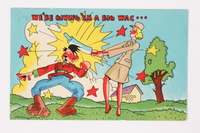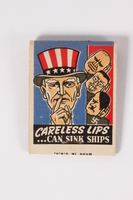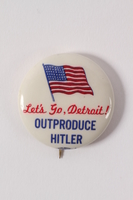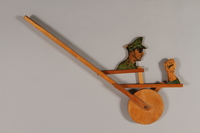Overview
- Brief Narrative
- Anti-Nazi pin-back button distributed in the United States during World War II. The pin falsely claims that Adolf Hitler’s real name is Adolf Schicklgruber (misspelled on the pin as Schickelgruber). An assertion which was originated by Hans Habe, a Viennese Jewish writer. The claim was based on the last name of Hitler’s father, who was born Alois Shicklgruber. Before Hitler was born, Alois changed his name and it became Alois Hitler. The motif of Hitler’s “real” name was likely an attempt to ridicule the leader and belittle him to the public. Buttons of this type came in various sizes, ranging in diameters from under 1 inch to 3.5 inches. The Adolf Schicklgruber motif was also used on other ephemera, such as posters. After the Japanese surprise attack at Pearl Harbor on December 7, 1941, and Germany’s declaration of war four days later, a wave of American patriotism and anti-Axis sentiment swept through the country. Much of this was manifested through pieces of ephemera such as posters, buttons, pins, cards, toys and decals. Often such pieces would depict unflattering or caricatured images ridiculing the Axis leaders, along with a call to action for the public to aid in their defeat. This sentiment continued in America until the end of the war.
- Date
-
manufacture:
1941-1945
- Geography
-
distribution:
United States
- Credit Line
- United States Holocaust Memorial Museum Collection, Gift of Michael Zentman in memory of his grandparents, Max (Mordechai) and Johanna (Chana) Zentmann
- Markings
- front, top, printed, black ink : WANTED FOR MURDER
front, bottom, printed, black ink : ADOLF SCHICKELGRUBER / ALIAS [in italics] “HITLER” [Schicklgruber misspelled as Schickelgruber]
Physical Details
- Language
- English
- Classification
-
Identifying Artifacts
- Category
-
Badges
- Object Type
-
Pin-back buttons (lcsh)
- Genre/Form
- Buttons (Information artifacts)
- Physical Description
- Cream colored, metal pin-back button with an image of the head of Adolf Hitler in the center, flanked by two swastikas. Black, English text is printed below the image and along the top edge. The surface is flat with rounded edges. The back is recessed, silver-colored metal that is covered with a thin layer of surface rust. A vertical, thin metal pin with a pointed bottom end is attached just below the top edge. There is a small, red stain on the bottom edge.
- Dimensions
- overall: Height: 1.375 inches (3.493 cm) | Width: 1.250 inches (3.175 cm) | Depth: 0.250 inches (0.635 cm)
- Materials
- overall : metal, plastic, ink
Rights & Restrictions
- Conditions on Access
- No restrictions on access
- Conditions on Use
- No restrictions on use
Keywords & Subjects
Administrative Notes
- Legal Status
- Permanent Collection
- Provenance
- The pin-back button was donated to the United States Holocaust Memorial Museum in 2015 by Michael D. Zentman.
- Record last modified:
- 2023-06-28 09:37:38
- This page:
- https://collections.ushmm.org/search/catalog/irn610289
Download & Licensing
In-Person Research
- By Appointment
- Request 21 Days in Advance of Visit
- Plan a Research Visit
- Request to See This Object
Contact Us
Also in Michael D. Zentman collection
The collection consists of American anti-Hitler, anti-Axis, and anti-Stalin propaganda materials, including pins, postcards, toys, advertisements, envelope, and other ephemera.
Date: 1941-1945
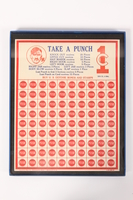
Buy US defense bonds Take a Punch at Hitler game
Object
Punch card game encouraging people to buy US Defense bonds and stamps. The United States Treasury Department sponsored 8 war loan drives from 1942 to 1945. The public could purchase a $25 war bond for $18.75 to help pay for the military’s expenses. The war bond could be redeemed 10 years after purchase for the full $25. If you could not afford a war bond, you could buy a war stamps, starting at 10 cents, which could be saved to purchase a bond. Bond quotas were set up on the national, state, county, and town levels to encourage the sale of war bonds. Volunteers went door-to-door to sell war bonds. It was considered a patriotic duty and an investment in victory. By the end of the war, 85 million Americans had purchased $185.7 billion dollars worth of bonds.
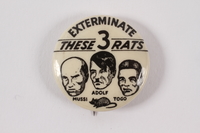
Anti-Axis pin calling for the extermination of Axis rats
Object
Anti-Axis pin-back button distributed in the United States during World War II. The button compares the leaders of Germany, Italy, and Japan to rats and calls for their extermination. The name under the Japanese face, referred to as Togo, may refer to Shigenori Tōgō, who was Minister of Foreign Affairs at the beginning of the war. The name may also be a misspelling of Tojo, a reference to Hideki Tojo who was Prime Minister of Japan during the war and a more popular target of American propaganda. After the Japanese surprise attack at Pearl Harbor on December 7, 1941, and Germany’s declaration of war four days later, a wave of American patriotism and anti-German, Italian and Japanese sentiment swept through the country. Much of this was manifested through pieces of ephemera such as posters, buttons, pins, cards, toys and decals. Often such pieces would depict unflattering or caricatured images of the Axis leaders along with a call to action for the public to aid in their defeat. This sentiment continued in America until the end of the war.
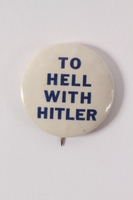
To Hell with Hitler pin
Object
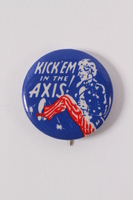
Kick 'em in the Axis pin
Object




